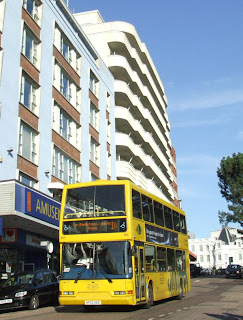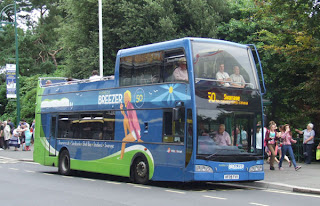 Bournemouth lies on the south coast of England. The town is flanked by Poole to the west and Christchurch to the east. The whole conurbation is home to nearly 380,000.
Bournemouth lies on the south coast of England. The town is flanked by Poole to the west and Christchurch to the east. The whole conurbation is home to nearly 380,000.Like many British coastal towns, Bournemouth expanded rapidly in the 19th Century and early 20th Century. The arrival of railways brought holidaymakers to coastal resorts, and many were attracted to Bournemouth for its sandy beaches.
A century later, cheap air travel brought foreign holidays within reach of many more people. Many of Britain's coastal towns fell into decline as holidaymakers headed for places with more predictable weather. Bournemouth has bucked the trend. The town remains a popular holiday destination, but is also home to a conference centre, a university and a number English language schools.
Bournemouth has not one transport network but two. Two bus companies operate services across the conurbation, competing with each other over the busiest corridors.
 Yellow Buses is the successor to Bournemouth's council-owned tram system. Trams were replaced by trolleybuses in the 1930s. Three decades later, trolleybuses gave way to diesel-powered buses. The bus fleet remained in council ownership until 2005 when it was sold. By a quirk of fate, it is now Government-owned - but not by the UK government. Yellow Buses is a subsidiary of Paris-based RATP, owned by the French state.
Yellow Buses is the successor to Bournemouth's council-owned tram system. Trams were replaced by trolleybuses in the 1930s. Three decades later, trolleybuses gave way to diesel-powered buses. The bus fleet remained in council ownership until 2005 when it was sold. By a quirk of fate, it is now Government-owned - but not by the UK government. Yellow Buses is a subsidiary of Paris-based RATP, owned by the French state. The Yellow Buses fleet is a mixture of single-deck and double-deck buses. All have a single door for entry and exit.
The Yellow Buses fleet is a mixture of single-deck and double-deck buses. All have a single door for entry and exit. 






Yellow Buses' competitor is Wilts & Dorset. At one time state-owned (by the UK Government!) it was sold into private ownership in the 1980s and is now part of the Go-Ahead group.
 The trunk corridor linking Poole and Bournemouth is hotly contested by Wilts & Dorset and Yellow Buses. Yellow Buses generally operate double-deckers every 7-10 minutes, while Wilts & Dorset run twice as frequently with single-deckers. In recent years, Wilts & Dorset's buses on these routes have been branded as "More".
The trunk corridor linking Poole and Bournemouth is hotly contested by Wilts & Dorset and Yellow Buses. Yellow Buses generally operate double-deckers every 7-10 minutes, while Wilts & Dorset run twice as frequently with single-deckers. In recent years, Wilts & Dorset's buses on these routes have been branded as "More".
Beyond Bournemouth, the "More" services run alternately eastwards to Southbourne (route m2), where they compete against the same Yellow Buses route from Poole, or north to Castlepoint (route m1) in competition with another Yellow Buses route.

 The
"More" brand has been refreshed with a brighter shade of blue compared
to the original. In summer 2012, one or two vehicles were still
carrying the previous darker blue livery.
The
"More" brand has been refreshed with a brighter shade of blue compared
to the original. In summer 2012, one or two vehicles were still
carrying the previous darker blue livery.
"More" buses aren't restricted to the m1 and m2 routes, although other buses still carry the Wilts & Dorset name and a livery with more red.



 Routes X1 and X2 run eastwards along the coast to the town of Lymington.
Routes X1 and X2 run eastwards along the coast to the town of Lymington.
 Routes X3 and X6 head in a more northerly direction to Ringwood, with route X3 continuing onwards to Salisbury.
Routes X3 and X6 head in a more northerly direction to Ringwood, with route X3 continuing onwards to Salisbury.
Not all Wilts & Dorset buses are red and blue. Those on route 50, which runs west from Bournemouth to the seaside town of Swanage, are branded "Purbeck Breezer". The 50 is a scenic journey along the coast and through the Purbeck Hills. For many years, the route has been operated with open-top double-deck buses during the summer season.
Poole Harbour provides a natural barrier between the Bournemouth conurbation and the Isle of Purbeck. Route 50 crosses the mouth of Poole Harbour using a chain ferry.
Route 50's summer frequency has increased in recent years. By summer 2012, it had risen to 3 buses per hour. This has increased the number of buses required to run the service so, although the route is advertised as open top, a proportion of the service was being provided by closed-top buses. Some were branded for route 40 (Poole to Swanage), from which they had been borrowed.

Bournemouth's railway station is a kilometre or two from the town centre and seafront. Both operators run frequent services to and from the station.
Passengers arriving by train can buy a "PlusBus" ticket allowing them unlimited travel throughout the conurbation using the services of both bus companies. However, at £3.50 per adult, the ticket is more expensive than two single tickets. Passengers who will only use the bus to get from the station to the centre of Bournemouth and back can do so more cheaply by buying tickets from the driver as they board the bus. This does, however, increase the amount of time the bus spends at the stop. Both operators have introduced smartcard ticketing systems as an alternative to paying cash fares.
The PlusBus ticket is one of only two which can be used on the services of both operators. The other is the "Getting About Card" promoted jointly by Bournemouth and Poole councils. At £5.50 for a day's unlimited travel, it is more expensive than the one-day tickets offered by either Yellow Buses or Wilts & Dorset for their own services.
Passengers wanting to buy a longer period pass can buy one for either of the two operators, but these are only valid on that operator's buses. The same is true of smartcards. There is no period ticket nor a smartcard which allows travel on both operators' buses.
Go-Ahead also submitted a bit to buy Yellow Buses in 2005. Had their bid succeeded, it is probable that the Wilts & Dorset and Yellow Buses services would have been merged into a single unified network (this had happened further along the south coast in Brighton, when Go-Ahead added Brighton Buses to their existing Brighton & Hove operation).
 It could be argued that Bournemouth has not two but three bus networks. A bespoke network of four routes is provided on behalf of Bournemouth University. Three of the routes operate only during term time, but a limited service runs on route U1 during university holidays. No services operate at weekends.
It could be argued that Bournemouth has not two but three bus networks. A bespoke network of four routes is provided on behalf of Bournemouth University. Three of the routes operate only during term time, but a limited service runs on route U1 during university holidays. No services operate at weekends. Double-deck and single-deck buses used on the Bournemouth University services carry a distinctive livery of white, grey and pink.
Double-deck and single-deck buses used on the Bournemouth University services carry a distinctive livery of white, grey and pink.

Some journeys on the U1 service are operated with an articulated bus. One such vehicle carries the Bournemouth University livery but a blue vehicle sometimes operates in its place.

The Bournemouth University services are operated by Wilts & Dorset. The routes can be used by the general public as well as students and staff of the university. Wilts & Dorset's one-day and period tickets are valid for use on these services. You won't find any mention of them on Wilts & Dorset's More website, though - the university services have their own site here.
 A shuttle service linking Bournemouth town centre and railway station with the airport is operated by another company, Discover Dorset. Buses run every hour, 7 days a week, from early morning to early evening. Although the UK has not adopted the Euro, tickets for the ariport shuttle can be bought using Euros.
A shuttle service linking Bournemouth town centre and railway station with the airport is operated by another company, Discover Dorset. Buses run every hour, 7 days a week, from early morning to early evening. Although the UK has not adopted the Euro, tickets for the ariport shuttle can be bought using Euros.
The airport shuttle has its own website here.

An open-top sightseeing tour of Bournemouth operates from the end of March to the end of September. It is operated by City Sightseeing.









































